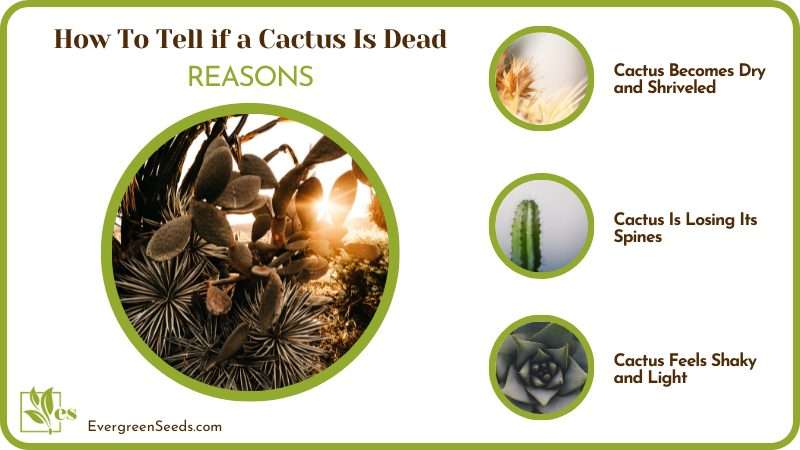- When to Plant Zucchini in Maryland: Optimal Times for Success - June 27, 2024
- When to Plant Grass Seed in Austin TX: Best Seasons and Techniques - June 27, 2024
- When to Plant Butternut Squash in NC: Best Times and Tips for Success - June 27, 2024
If you are wondering how to tell if a cactus is dead, you first need to understand that although cacti are relatively easy to care for and do not need much care, they would come to collapse if the right growing conditions that they need are not achieved. It can be worrisome for a cactus-keeper to see their beloved plant looking sickly.

With this in mind, continue reading below to find out the signs to look out for to determine if something is wrong with your cacti.
How Do You Know if Your Cactus Is Dead?
If your cactus looks dry and shriveled, feels shaky and light, has changed in color, is losing its spines, or is soft, mushy, and emits a foul odor, then there is a good chance that your plant may be dying or have already died.
Growing cactus plants is as easy as ABC, especially as they are known for being low-maintenance plants. They are often recommended as gardening novice plants because they are difficult to kill. However, dying is unavoidable, as even the most nurtured plants could encounter their downfall.
If you are curious whether or not your cactus is suffering distress, continue to read below, and let us discuss one by one the indications that can help you identify if your cactus is dead.
– Cactus Becomes Dry and Shriveled
One of the signs that could tell you if your cactus is dead is its outside appearance. One thing to consider in how to tell if cactus is healthy if its leaves looked plump and firm. If you notice that your cactus has withered or shriveled up, then your plant is in trouble or might already be dead.
This means they do not receive enough water, which gives them a shriveled look. You may see that the leaves are turning brown in color and dried up, or the stems have been cracked or become brittle. If this occurs, water your plant until the soil is completely wet but not overwatered. If watering is not enough, you might have to check for some signs of root rot.
– Cactus Feels Shaky and Light
If you observe that when you lift your cactus it feels light, hollow, or shaky in its soil, that may be a sign that it is dead. When your cactus becomes unstable, it means that your cactus roots are no longer sucking in nutrients from the soil and can no longer support them.

This typically happens due to root rot or when the cactus roots turn brown caused by overwatering or underwatering over time.
– Cactus Has Changed in Color
It is actually normal for cacti to change in color, which is attributable to environmental conditions like age, sunlight exposure, and temperature, but if you see that there are other indicators together with discoloration, then your cactus is dying or already dead.
A dead cactus loses its green pigment when it dies. Leaves will start turning yellow at first and then eventually start turning brown or gray entirely because the chlorophyll in the leaves dies with it.
Some browning of the leaves is normal, especially for older cacti. This is a natural process of aging called corking, which is something you should not worry about.
Corking typically starts from the bottom of the plant and progresses upward. Cacti also turn red. Sometimes, this kind of discoloration is caused by environmental stress and can be mended if the cause of it is reversed.
If there is discoloration, just make sure to give your cactus extra care, and pay more attention to your plant over the next few weeks.
– Cactus Is Losing Its Spines
Aside from losing their chlorophyll, cacti also lose their spines when they are dying or dead. Some brown or black discoloration around the spine is noticeable before it falls off.
However, the loss of its spine does not necessarily mean your cactus is dead. Sometimes, it is a result of issues with recent transplanting or growth, and sometimes, spines just fall off on their own, which is a normal process.
Check your cacti and see if they used to have strong and healthy spines but suddenly lost them all. This might mean your cactus might be dying. If there is no more growth and the spines are falling off, then consider your plant dead. The main cause of the loss of the spines is root rot.
– Cactus Is Soft, Mushy, and Has a Foul Smell
The cactus releasing a foul smell is an indicator that it is dead and is already rotting. If the rot infected the rest of the plant, it is already impossible to revive your cactus, but if you catch the rot early enough, you can cut the rotting part, throw it away, and your plant might have a chance to recover because rot can sometimes be treated.
In addition to the foul smell, rotten cacti also appear mushy, wet, soft, and infested by insects. Rot is a result of overwatering or underwatering, and spreading to the rest of the plant can be avoided if diseased parts are cut off. The same goes with molds.
How To Revive a Dead or Dying Cactus?
Fixing root rot, replanting your cactus, keeping track of watering, adjusting light and temperature, preventing pests and diseases, and using fertilizer can help your dead or dying cactus go back to healthy living.
After reading the indicators of whether your cactus is dead and confirming that it is, the next question that will come to mind might be “can you revive a dead cactus?” Well, fortunately, cacti can regenerate just from a small portion of healthy tissue, so yes, you can revive your dead plant. Especially if you can see white spots on your cactus, then you can definitely revive it.
In this section, we list down some cactus care tips and various steps you need to follow to revive your plant and help it thrive.
– Check for and Fix Root Rot
The first thing you might want to check is the main reason why your cactus is dying, and the most common reason is root rot. So, addressing and fixing this problem is the best first step for you to take.
Rotting in your cactus roots is a very common issue. Cacti easily develop this condition because they are typically planted in small pots that have a poor drainage system and are often given too much water.
Thankfully, this condition is easy to address, especially if you diagnose it earlier. Signs you should look out for are mushy roots, shakiness, and discoloration such as brown spots. If you encounter these signs, then it is confirmed you are dealing with cactus rot and should act quickly.

The essential thing you will need to do now is to cut the rotting parts with a clean knife and throw them away. Allow the cut part to dry out before repotting it, and pause watering until the wound closes.
Usually, cacti respond well to this method. However, if the root rot is affecting a large area of the roots, saving your plant might already be impossible. This is why it is important for you to be able to diagnose this condition earlier and act immediately.
Although it is challenging, your plant can recover with the right care. However, if you are too late, the only thing you can do is to grow a new plant using cuttings from your dying cactus.
– Replant Your Cactus
After giving your dead cactus a second life by getting rid of the rotting parts, allow it to regenerate by replanting it in a new pot with new soil.
You should also consider repotting when you notice your plant is already too big for its pot, when the leaves look unhealthy, when the water you give is running through the pot, or when the roots are already crowded.
Repotting allows your plant to have a larger growing space and prevents the roots from becoming overly crowded, which results in stunted growth and can lead to demise.
When doing cactus potting, choose a pot that is a little larger than your current pot, not too large nor too small. You should first disinfect the new pot using one part of bleach and one part of water to get rid of any bacteria that may be present.
The cactus soil you should use is a mix of two parts garden soil, two parts coarse sand, and one part peat or you should consider using porous potting soil, which is claimed to be great in draining or becoming saturated quickly, absorbing water excess, and resisting the pathogens that cause root rot.
– Keep Track of Your Watering
Given that overwatering is the most common cause of root rot, monitoring your watering should help you to keep your cactus healthy.
Cacti are desert plants, meaning the desert is their natural habitat. Thus, mimicking the growing conditions in the desert is a good idea. Now, how to tell if cactus needs water?
Keep in mind that cacti are drought-resistant, so giving them less water rather than more is better. They don’t need an abundance of water but rather a regular watering schedule to allow them to grow.
Your plant will give you hints if you are overwatering or underwatering it. If you notice your cactus turning brown or if it starts to look wilted, dry, and calloused, you are under-watering it. However, if it is becoming mushy, which can lead to root rot, then you are overwatering.
Keeping track of your watering is the best solution to this issue. Begin to reduce the amount of water you give, and monitor how frequently you are watering your plant. It is also essential to allow the soil to completely dry out between waterings, and consider adjusting the watering based on the season and temperature.
– Adjust Daily Sunlight and Temperature
Lack of light can also lead to the demise of your cactus plant, so it is important to keep an eye on this factor as well. Cacti need a proper amount of light; otherwise, they would become pale, floppy, or shed their leaves.
To prevent these things from happening, give your cactus a light source, whether it is artificial or natural. You can situate your cacti on a windowsill if they are indoors and not too much direct sunlight if outdoors, just like Christmas cactus.
If you prefer an artificial light source, choose LED bulbs to increase the light exposure your plant receives. However, be careful not to give cacti more light exposure than they need because it can lead to corking and sunburn.
Another thing is to allow your plant to process the light properly by cleaning its flesh that is covered with dust or dirt. You can use a rag or soft sponge soaked in diluted drops of dish soap and water to wipe your plant. You can rinse it under the faucet in the sink if indoors and use a hose if outdoors.
In addition to light exposure, the temperature where you keep your cactus is another thing to watch out for. The ideal temperature that cacti need is between 65 to 90 degrees Fahrenheit, but during cold spells, you might want to increase these temperatures to encourage proper growth.
– Look Out for Pests and Insects
Invasive pests and insects are very common nuisances in plants. In the case of your cactus, mealybugs, to be specific, are the one who loves to attack your plant. They feed on foliage by sucking the sap from the plant.
They also excrete sticky wax, reducing the quality of your cactus. There are also spider mites that look like tiny red spiders that cause injury by feeding on the sap, which also causes them stress and frequently kills plants.
Avoid these insects, especially if they come in large quantities, by applying some natural remedies.
For mealybugs, you can kill them either by dabbing a cotton swab with denatured alcohol and repeating the steps until all the bugs are removed, or spray your cactus using a few drops of dish soap diluted into one cup of water; repeat this often for your plant to benefit from the full effect. For spider mites, you can get rid of them by purchasing solutions in a local nursery.
– Use Fertilizer
Consider feeding your cacti with a recommended fertilizer to give them proper nutrition. Although cacti can still thrive even without fertilizer, extra nutrition will make them vigorous.
It is ideal to feed your plant with a cactus fertilizer every two weeks from spring through early fall and once a month during the winter and fall seasons.

Make sure that you are not overfertilizing your cacti because this could lead to many growth issues, such as inadequate nutrition. Check for some signs of improper nutrition.
For example, if you notice that your cactus’ leaves are getting soft as a cloth or turning brown in color, then you are overfeeding your plant. Be careful to always follow the instructions indicated on the packaging of the fertilizer.












